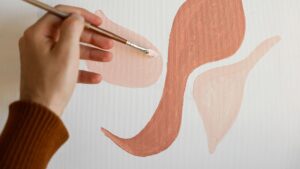You can repair damaged areas of wall paint on canvas. Whether it’s due to scratches, scrapes, or discoloration, here’s a comprehensive guide on how to rejuvenate your canvas and restore its original charm.
Understanding the Damage
Identify the Problem: Before diving into repairs, examine the damage. Is it a minor scratch, a deep scrape, or discoloration? Understanding the extent helps in choosing the right approach.
Tools and Materials
Gather Supplies: You’ll need sandpaper (fine-grit), primer, paint (matching the original color), small paintbrushes, and a clear sealant. Ensure these are of good quality for better results.
Step-by-Step Repair Process
1. Prepare the Surface
- Clean the damaged area gently with a damp cloth to remove dust and debris.
- Use fine-grit sandpaper to smooth the damaged area, ensuring the surface is even.
2. Apply Primer
- Apply a thin layer of primer over the repaired area and let it dry completely. Primer helps the paint adhere better and ensures an even finish.
3. Paint Touch-Up
- Using a small paintbrush, carefully apply the paint matching the canvas. Start with a thin layer and let it dry.
- If needed, apply multiple thin layers to match the texture and color accurately. Patience is key here.

A Person Painting on a Canvas m
4. Seal the Repair
- Once the paint is dry, apply a clear sealant to protect the repaired area. It helps to maintain the paint and prevents future damage.
Tips for a Successful Repair
- Patience Pays Off: Take your time with each step for a seamless finish.
- Color Matching: Blend the colors well for a natural look. Consider mixing paints to get the exact shade.
- Test in Small Areas: Before applying the repair on the canvas, test it on a small inconspicuous area to ensure it matches perfectly.
So,….
Repairing damaged areas on a canvas isn’t as daunting as it may seem. With the right tools, patience, and a little effort, you can restore your canvas to its former glory, preserving its beauty for years to come.
External Resources:
- The Spruce – How to Repair Canvas Art
- The Art Sherpa – Restoring Damaged Canvas
- WikiHow – Repairing a Canvas Painting
Give these techniques a try and witness the transformation of your damaged canvas
Understanding Common Issues
Scratches and Scrapes
- Light Scratches: Use a soft eraser or a cotton swab with a tiny bit of rubbing alcohol to gently buff the area.
- Deeper Scrapes: Apply a thin layer of gesso over the damaged spot. Once dried, follow the painting process mentioned earlier.
Discoloration or Fading
- Sunlight Damage: If the damage is due to exposure to sunlight, consider using UV-resistant varnish to protect the canvas and prevent further fading.
- Cleaning Stains: For stains, use a mild soap and water solution on a soft cloth to gently clean the area. Dry it completely before applying any touch-ups.
Tears or Rips
- Repairing Tears: For small tears, use canvas patching material, carefully applying it to the back of the canvas. Secure it firmly and proceed with the painting process on the front side.
Preventive Measures for Future Protection
- Proper Storage: Store canvases away from direct sunlight and extreme temperatures to prevent damage.
- Regular Cleaning: Dust the canvas regularly with a soft brush or microfiber cloth to prevent debris buildup.
- Avoid Humidity: Keep the canvas away from humid areas to prevent mold growth or warping.
Conclusion
Repairing damaged areas on a canvas requires a delicate touch and attention to detail. By following these steps and tips, you’ll be able to breathe new life into your canvas art, allowing you to enjoy its beauty for years to come.
Remember, each repair is unique, so assess the damage carefully before proceeding. Don’t hesitate to seek professional help if the damage seems too complex to handle yourself.
By investing time and care into these repairs, you’ll preserve not just the canvas but also the memories and emotions tied to the artwork.
External Resources:
Comparison tabular
| Aspect | Minor Scratches | Deep Scrapes | Discoloration/Fading |
|---|---|---|---|
| Repair Method | Use soft eraser or rubbing alcohol on swab | Apply gesso layer before repainting | Use UV-resistant varnish for protection |
| Materials Needed | Soft eraser, rubbing alcohol, cotton swab | Gesso, paint, brushes | UV-resistant varnish |
| Complexity | Low | Moderate | Low |
| Time Required | Minimal | Moderate | Minimal |
| Preventive Measures | Regular cleaning, proper storage | Regular cleaning, UV protection | UV protection, proper storage |
This table outlines the different types of damage and their respective repair methods, materials required, complexity, time needed, and preventive measures. It provides a quick glance at the approaches for handling various issues with damaged canvas art.
Wrapping up
Repairing damaged areas on canvas may seem daunting at first, but with the right tools, patience, and care, it’s a rewarding process. Each stroke of paint or patching of a tear brings your canvas back to life, preserving not just the physical artwork but also the emotions and memories it holds.
Remember, the key is to assess the damage, gather the necessary materials, and take your time through each step. Whether it’s a small scratch or a significant discoloration, there’s a method to restore and revive your canvas.
By following these techniques and preventive measures, you’re not just repairing the damage; you’re prolonging the life of your cherished artwork. Embrace the process, enjoy the journey, and relish the satisfaction of seeing your canvas restored to its former glory.
So, roll up your sleeves, gather your supplies, and embark on this artistic journey of rejuvenation. Your canvas awaits its transformation, and with these steps, you’re well-equipped to revive its beauty.

For over a decade, I’ve been Mike, an artist, crafter, and designer deeply immersed in the Croc world. I thrive on crafting unique, size-inclusive patterns, fostering creativity, and sharing them on ktforum.com. My designs aim to ignite your creative spark and delight you, ensuring clarity and ease of use through rigorous testing. Join me in expressing your creative flair and showcasing your craft with joy.
Related Posts
- Ensuring Longevity: Wall Paint on Canvas
When it comes to painting, the canvas serves as an artist's playground, a surface that…
- Exploring Temporary Art with Wall Paint on Canvas
When it comes to art, experimentation knows no bounds. Have you ever considered using wall…
- Techniques for using wall paint on canvas
Painting on canvas with wall paint can yield fantastic results, but it requires a few…
- Can You Paint Over Existing Wall Paint on Canvas
If you're an aspiring artist or someone enthusiastic about trying their hand at painting, you…

